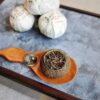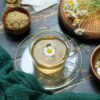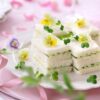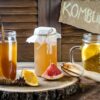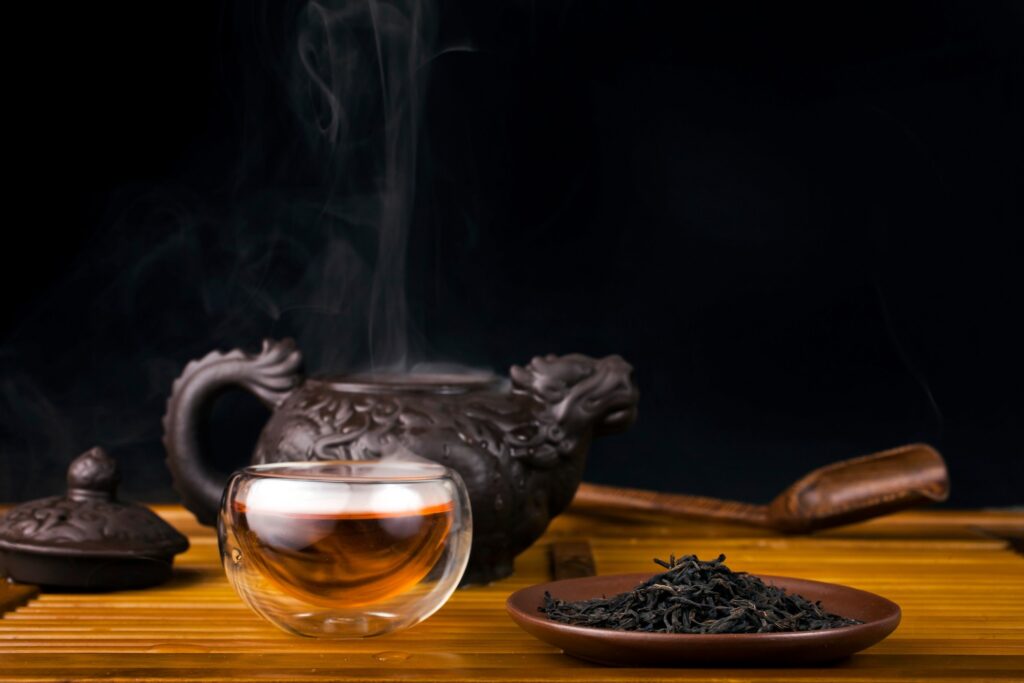
Lapsang souchong, a tea with a captivating aroma and bold flavor, has carved a unique niche in the world of fine teas. This extraordinary brew, originating from the revered tea-growing regions of China, has mesmerized connoisseurs and casual drinkers alike with its distinctive smoky notes and robust character.
Lapsang souchong stands apart from its counterparts, offering a sensory experience that transcends the ordinary. Its allure lies in the harmonious blend of bold smokiness and subtly nuanced flavors, creating a captivating symphony for the palate. Whether you’re a seasoned tea enthusiast or a curious explorer, this guide will unveil the secrets behind this remarkable tea, allowing you to savor its complexity and embrace its rich heritage.
As you embark on this journey, prepare to be transported to the misty mountains and ancient tea gardens where lapsang souchong’s story unfolds. Immerse yourself in the art of tea appreciation, and discover the nuances that make this brew a true masterpiece in the world of fine teas.
The History and Origins of Lapsang Souchong Tea
The tale of lapsang souchong is steeped in legend and tradition, dating back to the Qing Dynasty in the 17th century. According to folklore, the tea’s distinctive smoky aroma was born out of necessity during a tumultuous time when the village of Tong Mu was under threat of invasion. To protect their precious tea leaves from plundering soldiers, resourceful tea farmers sought refuge in nearby caves, where they ingeniously dried the leaves over pine wood fires.
This serendipitous event not only preserved the tea leaves but also imbued them with a unique, smoky essence that would become the hallmark of lapsang souchong. The tea’s name itself is a testament to its origins, with “lapsang” referring to the region where it was first produced, and “souchong” denoting the fourth or fifth plucking of the tea leaves during the season.
As word of this remarkable tea spread, its popularity soared, and lapsang souchong became a coveted commodity among tea connoisseurs and traders alike. Today, the traditional methods of production have been refined and perfected, ensuring that each batch of lapsang souchong captures the essence of its storied past while adhering to modern standards of quality and consistency.
The Unique Characteristics of Lapsang Souchong Tea
Lapsang souchong stands apart from other teas due to its distinctive characteristics, which are the result of a meticulous production process. The tea leaves undergo a unique drying and smoking process that imparts a rich, smoky aroma and flavor unlike any other.
One of the most remarkable aspects of lapsang souchong is its appearance. The tea leaves are large, twisted, and dark in color, ranging from deep brown to nearly black. This striking appearance is a direct result of the smoking process, which not only infuses the leaves with smoky notes but also alters their physical characteristics.
When brewed, lapsang souchong yields a deep, reddish-brown liquor that exudes an unmistakable aroma reminiscent of a campfire or smoldering embers. This smoky fragrance is often likened to the scent of pine or cedar wood, adding to the tea’s allure and unique character.
On the palate, lapsang souchong offers a complex array of flavors. The initial sip reveals a bold, smoky taste that lingers on the tongue, followed by subtle notes of caramel, dried fruit, and a hint of earthiness. The tea’s robust body and rich mouthfeel make it a truly indulgent experience, inviting sip after sip.
How Lapsang Souchong Tea is Processed
The processing of lapsang souchong tea is a labor-intensive and meticulous endeavor, steeped in tradition and mastered over generations. The journey begins with the careful selection of tea leaves, typically from the Camellia sinensis plant, which are handpicked during the spring and early summer months.
Once the leaves are harvested, they undergo a series of steps that transform them into the distinctive lapsang souchong tea:
- Withering: The freshly plucked leaves are spread out and allowed to wither, a process that reduces their moisture content and concentrates their flavors.
- Rolling: The withered leaves are gently rolled, either by hand or machine, to break down their cellular structure and release their essential oils and enzymes.
- Drying: This crucial step sets lapsang souchong apart from other teas. The rolled leaves are placed in bamboo baskets or trays and exposed to the smoke from pinewood fires, typically fueled by pine or cypress logs. The smoke permeates the leaves, imparting the characteristic smoky aroma and flavor.
- Oxidation: After the smoking process, the leaves are allowed to oxidize, a chemical reaction that further develops their flavor and aroma.
- Final Drying: The oxidized leaves undergo a final drying process to remove any remaining moisture, ensuring their longevity and preserving their smoky essence.
Throughout the production process, skilled tea masters carefully monitor and adjust the temperature, humidity, and smoke intensity to achieve the desired level of smokiness and flavor complexity. This meticulous attention to detail ensures that each batch of lapsang souchong tea captures the essence of its rich heritage.
Brewing Lapsang Souchong Tea: Tips and Techniques
Brewing lapsang souchong tea is an art form in itself, requiring precision and care to unlock its full potential. To truly appreciate the depth of flavors and aromas this tea has to offer, it is essential to follow a few key steps:
- Water Temperature: Lapsang souchong tea benefits from slightly cooler water temperatures, typically between 195°F and 205°F (90°C and 96°C). Boiling water can cause the tea to become bitter and harsh, masking its delicate nuances.
- Tea Leaf Quantity: For a robust and flavorful brew, use approximately 1 teaspoon of loose leaf lapsang souchong per 8 ounces (240 ml) of water. Adjust the amount according to your personal preference and the desired strength.
- Steeping Time: Lapsang souchong tea should be steeped for approximately 3 to 5 minutes. Shorter steeping times may result in a weaker brew, while longer steeping can lead to bitterness and astringency.
- Vessel: Choose a teapot or brewing vessel made of materials that won’t impart any unwanted flavors, such as glass, ceramic, or porcelain. Avoid metallic vessels, as they can react with the tea and alter its taste.
- Serving: Once steeped, lapsang souchong tea can be enjoyed plain or with a touch of honey, sugar, or lemon, depending on your personal preference. Some tea enthusiasts also enjoy adding a splash of milk or cream to complement the smoky notes.
Experiment with different brewing techniques and find the perfect balance that suits your taste buds. Remember, the art of brewing lapsang souchong tea is a journey of discovery, and each cup can reveal new layers of flavor and aroma.
Exploring the Flavor Profile of Lapsang Souchong Tea
Lapsang souchong tea offers a truly unique and captivating flavor profile, making it a standout among other teas. Its distinctive smoky character is undoubtedly the star of the show, but beneath this bold note lies a complex tapestry of flavors waiting to be explored.
At the heart of lapsang souchong’s flavor is its unmistakable smokiness, which can range from a subtle whiff of campfire to a robust, almost bacon-like intensity. This smoky essence is the result of the tea leaves being exposed to pine or cypress wood smoke during the drying process, imparting a rich, earthy aroma and taste.
Beneath the smoky veil, lapsang souchong reveals a depth of flavors that unfold with each sip. Notes of caramel and dried fruit, such as raisins or figs, lend a subtle sweetness to the brew, complementing the smoky undertones. Hints of toasted nuts, like almonds or hazelnuts, add a delightful nuttiness, while a touch of earthiness grounds the overall flavor profile.
As the tea cools, the flavors continue to evolve, revealing nuances of leather, tobacco, and even a whisper of cocoa or dark chocolate. These complex layers create a truly multidimensional sensory experience, captivating the palate and inviting contemplation with each sip.
The mouthfeel of lapsang souchong tea is equally impressive, offering a rich, full-bodied texture that coats the palate. Its robust character lingers pleasantly on the tongue, leaving a lasting impression long after the final sip.
Health Benefits of Lapsang Souchong Tea
Beyond its enticing flavors and aromas, lapsang souchong tea boasts a range of potential health benefits that make it a worthy addition to any wellness routine. Like other true teas derived from the Camellia sinensis plant, lapsang souchong is rich in antioxidants and beneficial compounds that may contribute to overall well-being.
- Antioxidant Properties: Lapsang souchong tea contains polyphenols, particularly catechins and theaflavins, which are potent antioxidants. These compounds help neutralize free radicals in the body, potentially reducing the risk of chronic diseases and promoting overall health.
- Cardiovascular Support: Studies have suggested that the consumption of lapsang souchong tea may contribute to improved cardiovascular health. Its antioxidant properties and the presence of compounds like thearubigins may help reduce inflammation and support healthy blood pressure levels.
- Digestive Aid: The smoky aroma and flavor of lapsang souchong tea are believed to have a calming effect on the digestive system. Its compounds may help alleviate discomfort associated with indigestion, bloating, and other gastrointestinal issues.
- Potential Weight Management: Some research indicates that the polyphenols found in lapsang souchong tea may have a positive impact on weight management. These compounds may help regulate metabolism and promote a healthy balance of gut bacteria, supporting overall wellness.
- Mental Alertness: Like other black teas, lapsang souchong contains a moderate amount of caffeine, which can enhance mental alertness and focus. However, its caffeine content is lower than that of coffee, making it a gentler option for those sensitive to high levels of caffeine.
It’s important to note that while these potential benefits are promising, more research is needed to fully understand the extent of lapsang souchong tea’s impact on human health. As with any dietary addition, moderation and consultation with a healthcare professional are recommended, especially for individuals with specific health concerns or conditions.
Pairing Lapsang Souchong Tea with Food
Lapsang souchong tea’s bold and smoky character makes it a versatile companion for a wide range of culinary delights. Its robust flavors can complement and enhance various dishes, elevating the overall dining experience. Here are some delightful pairing suggestions to explore:
- Smoked and Cured Meats: The smoky notes of lapsang souchong tea pair beautifully with smoked or cured meats like bacon, ham, and sausages. The tea’s robust flavor complements the savory richness of these dishes, creating a harmonious fusion of flavors.
- Grilled or Barbecued Fare: The smoky essence of lapsang souchong tea makes it an ideal accompaniment to grilled or barbecued meats, vegetables, and even fruits. Its bold character can stand up to the robust flavors of charred and caramelized foods, creating a delightful contrast and balance.
- Aged Cheeses: The depth of lapsang souchong tea pairs exceptionally well with aged cheeses like cheddar, gouda, or parmesan. The tea’s smoky notes complement the rich, nutty flavors of these cheeses, creating a delightful combination for a cheese board or appetizer platter.
- Chocolate Desserts: For those with a sweet tooth, lapsang souchong tea can be a surprising and delightful pairing with chocolate desserts. Its smoky undertones and subtle sweetness complement the richness of dark chocolate, creating a unique and indulgent flavor experience.
- Spicy Dishes: The bold character of lapsang souchong tea can help balance and complement the heat of spicy dishes, such as curries, chili, or Szechuan cuisine. The tea’s smoky notes can tame the fiery heat while enhancing the depth of flavors in these dishes.
When pairing lapsang souchong tea with food, it’s essential to consider the intensity of both the tea and the dish. Stronger brews may pair better with heartier fare, while lighter infusions can complement more delicate flavors. Experiment and let your taste buds guide you on a culinary adventure with this remarkable tea.
Where to Buy Lapsang Souchong Tea
As the popularity of lapsang souchong tea continues to grow, finding high-quality sources has become more accessible than ever before. Whether you’re a seasoned tea enthusiast or a curious newcomer, there are several options to explore:
- Specialty Tea Shops: Visit your local specialty tea shop or online retailers that specialize in fine teas. These establishments often carry a wide selection of lapsang souchong teas from various regions and producers, allowing you to explore different grades and flavor profiles.
- Online Tea Vendors: Many reputable online tea vendors offer a diverse range of lapsang souchong teas, providing detailed descriptions, tasting notes, and sourcing information. This option allows you to conveniently browse and purchase from the comfort of your home.
- Direct from Tea Estates: For the ultimate in freshness and authenticity, consider purchasing lapsang souchong tea directly from tea estates or producers in China. This approach ensures you receive the tea directly from the source, often with detailed information about the specific harvest and processing methods.
- Farmer’s Markets and Local Artisans: Seek out farmer’s markets or local artisans who specialize in sourcing and selling high-quality teas. These vendors often have a deep knowledge of the teas they offer and can provide valuable insights into the unique characteristics of each batch.
When purchasing lapsang souchong tea, pay attention to the packaging and storage conditions. Ideally, the tea should be stored in airtight containers away from light, moisture, and strong odors to preserve its smoky aroma and flavor. Additionally, consider purchasing small quantities at a time to ensure freshness and optimal enjoyment.
Embracing the Richness of Lapsang Souchong Tea
Lapsang souchong tea is a true masterpiece in the world of fine teas, offering a captivating blend of smoky richness and complex flavors. From its storied origins to its meticulous production methods, this extraordinary brew has captured the hearts and palates of tea enthusiasts worldwide.
Embracing the richness of lapsang souchong tea is an experience that transcends mere consumption. It is a journey of discovery, where each sip unveils new layers of flavor and aroma, inviting contemplation and appreciation for the art of tea craftsmanship.
As you embark on your own lapsang souchong adventure, remember to savor the moment, experiment with brewing techniques, and explore the countless pairing possibilities. Whether enjoyed on its own or paired with culinary delights, this remarkable tea promises to elevate your senses and transport you to a world of smoky indulgence.

